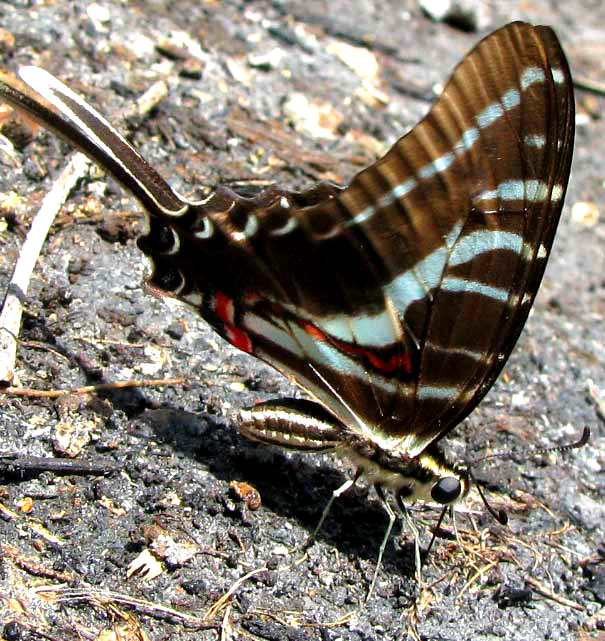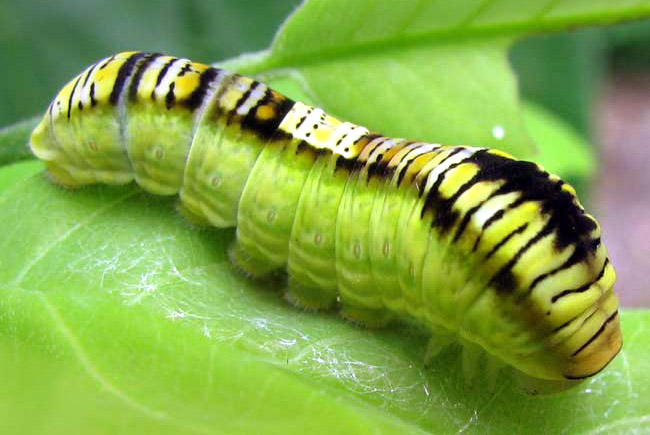Excerpts from Jim Conrad's
Naturalist Newsletter

from the April 25, 2010 Newsletter issued from Hacienda Chichen Resort beside Chichén Itzá Ruins, central Yucatán, MÉXICO; limestone bedrock, elevation ~39m (~128ft), ~N20.676°, ~W88.569°
DARK KITE-SWALLOWTAILS
Last week's unexpected rainstorm has engendered a whole new crop of butterflies. Maybe the most eye- catching are the ones who gather in groups of ten or so on the ground right outside my hut's door. That's where in the past the grounds people burned the big fronds that continually fall from our Royal Palms, so the soil there is black with ash, and maybe contains nutrients butterflies crave. A visitor is shown above.
The Northerner immediately thinks "Zebra Swallowtail" but if you'd see how this species flies so nervously and daintily, and how when it alights it quivers its wings as if it can hardly stand to touch the ground, you'd know that this species is more animated and "ethereal," like bubbly pixies, than the Northern Zebra.
Bea in Ontario pegs this is a Dark Kite-Swallowtail, EURYTIDES PHILOLAUS, found in deciduous and semideciduous tropical, lowland forests from southern Texas through here to Costa Rica. Even though it's considered a kite-swallowtail instead of just a plain swallowtail, it belongs to the Swallowtail Subfamily, the Papilioninae.
The great Butterflies and Moths of North America webpage on this species says that Dark Kite-Swallowtail caterpillars feed on members of the Anona Family. We have a few Anona trees here but it would seem not enough to support such large numbers of Dark Kite-Swallowtails. The site also says that the species is most numerous at the beginning of the rainy season, which is about now.
from the March 27, 2011 Newsletter issued from Hacienda Chichen Resort beside Chichén Itzá Ruins, central Yucatán, MÉXICO; limestone bedrock, elevation ~39m (~128ft), ~N20.676°, ~W88.569°
DARK KITE-SWALLOWTAILS AQUIVER
Sometimes the Dark Kite-Swallowtails separate themselves from the butterfly cloud circulating before the hut, land very near one another on ground I've moistened that morning with the hose, and vigorously quiver their wings.
Who knows why they do this? One guess is that it's very hot there on the moistness-darkened soil, and the quivering keeps cool air circulating among them. Another is that predators might be confused by all the rippling images. However, elsewhere dense, similar sized clusters of other butterfly species often sit perfectly still, and it's just as hot with them, and they're just as vulnerable to predators.
If your viewer can handle a You-Tube video and Javascript, you can watch some of the quivering below:
from the June 13, 2010 Newsletter issued from Hacienda Chichen Resort beside Chichén Itzá Ruins, central Yucatán, MÉXICO; limestone bedrock, elevation ~39m (~128ft), ~N20.676°, ~W88.569°
SNAKY CATERPILLAR
The rainy season's advent engenders lush greenness, and caterpillars to eat the greenness. The sheer numbers and kinds of caterpillars is mind boggling. From one day to the next leaves of every kind, from the ground to the forest's canopy, grow more tattered. A gentle shower of sandgrain-like caterpillar poop falls everywhere, all the time. Birds alight in random places and there's a juicy worm right there waiting for them.
Among all the caterpillar types at hand I choose just one to admire and think about. It's the one shown below:

In that picture the top inset shows a much smaller, younger instar (instar being a stage of development between five or so skin-molts a caterpillar goes through), camouflaged rather like a bird dropping. The larger caterpillar below, maybe in the last instar, has abandoned the bird-dropping look for a more threatening one. If you unfocus your eyes and look from a distance, and if the disturbed caterpillar raises its front end (lower right) and waves it back and forth, as it does in real life, the banded coloring on the caterpillar's top looks a good bit like a yellowish snake with a big head and black eye, almost like a hooded viper with his head curved forward.
Bea in Ontario writes, "That caterpillar looks like it might be a swallowtail caterpillar, because of its large 'shoulders' and the colors and pattern." On the Internet we can't find a photo of the Dark Kite Swallowtail's caterpillar, the Dark Kite being our most common swallowtail, but Bea did find caterpillar pictures for the closely related Mexican Kite Swallowtail, which are almost identical to those in the picture.
Therefore, since I've not seen Mexican Kite Swallowtail butterflies here, but Dark Kite Swallowtails flit by every day, I'm guessing that the caterpillar in the picture is a Dark Kite Swallowtail.